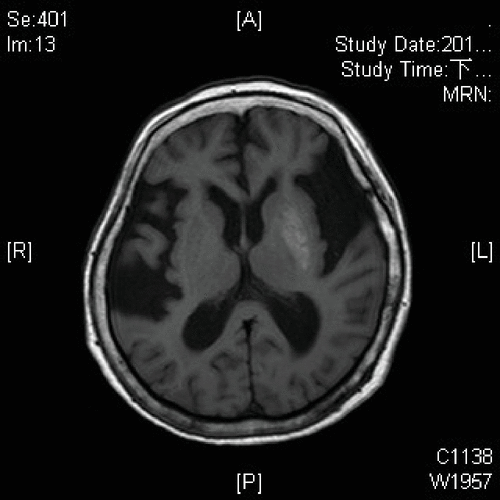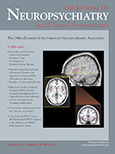Nonketotic Hyperglycemia Presenting as Choreoathetosis in a Female Schizophrenia Patient
To the Editor: Hemiballism or hemichorea caused by nonketotic hyperglycemia is an initial manifestation of diabetes. Here, we share our experience of the detection and treatment of nonketotic hyperglycemia-induced involuntary movement in a schizophrenia patient.
Case Report
Mrs. A is a 79-year-old woman with a diagnosis of schizophrenia from the time she was 28 years old. She was treated with thioridazine 100 mg per day from the time she was 47 years old. The medication was changed to risperidone 2 mg per day after she became 75 years old. She had no history of any systemic diseases, substance abuse, or head injury.
She presented to our hospital in March 2013 with a 2-week history of involuntary movements such as sudden-onset, continuous, and nonrhythmic movements in the form of flailing and twisting involving her right limbs. Her psychotic symptoms remained stationary. Neurological examination revealed normal muscle power without cerebellar signs or cranial nerve palsy. The most striking finding was choreoathetosis over the right limbs with prominence in the upper limbs. Electroencephalography revealed generalized, intermittent theta slowing. Laboratory examination showed HbA1C 14.4%, triglyceride 252 mg/dl, total cholesterol 200 mg/dl, and fasting blood glucose 309 mg/dl; hemogram, liver enzyme, renal function, and thyroid profile were within normal limits. MRI of the brain showed T1 hyperintensity at left basal ganglion (Figure 1). After treatment with metformin 500 mg per day, the involuntary movement diminished gradually and disappeared 2 weeks later. The fasting sugar and HbA1C returned within normal limits 3 months later. Up to this point, the involuntary movement never recurred.

Figure 1. MRI of the Brain Showing T1 Hyperintensity at Left Basal Ganglion
Discussion
Our patient presented with acute onset of involuntary choreoathetosis movement over the right limbs. Vascular lesion at subthalamic nucleus was the most possible cause.1 However, MRI revealed TI hyperintensity at left basal ganglion instead of subthalamic lesion.2 Meanwhile, hyperglycemia was noted, and the involuntary movement remitted after diabetes control.
In addition to vascular lesion, metabolic derangements, hyperglycemia, hyperthyroidism, tumor, and infection are associated with hemiballism or hemichorea/choreoathetosis.1 Sometimes, hemiballism or hemichorea caused by nonketotic hyperglycemia is an initial manifestation of diabetes, especially for elderly Asian females.3,4The typical brain MRI findings of these nonketotic hyperglycemia- induced involuntary movement are increased signal intensity on T1-weighted images over striatum and, similarly, left basal ganglion T1 hyperintensity were noted in our patient. After correcting the metabolic derangement, her involuntary movement ceased. In previous studies, the abnormalities of neuroimaging were shown to be reversible.3 We suggest that our patient’s acute hemichoreoathetosis was caused by hyperglycemia, despite lack of following imaging study.
Because our patient was a case of chronic schizophrenia, tardive dyskinesia induced by long-term neuroleptics use should be considered, and the manifestations that differed from our patient were involuntary movements mainly over tongue, lips, jaw, and extremities with insidious onset and slow progress. To the best of our knowledge, this is the first report of a schizophrenic patient with hemiballism or hemichorea caused by nonketotic hyperglycemia; 42.7% of patients treated with second-generation antipsychotics had metabolic dysregulation in previous literature.5 Our patient presented with a movement disorder caused by nonketotic hyperglycemia without a previous history of diabetes. Correct metabolic derangement achieved complete remission of movement disorder. Metabolic profiles should be assessed periodically in schizophrenia patients, and patients with new-onset involuntary movement should be evaluated for the probable metabolic comorbidities.
1 : Hemiballism-hemichorea. Clinical and pharmacologic findings in 21 patients. Arch Neurol 1989; 46:862–867Crossref, Medline, Google Scholar
2 : Presentation of striatal hyperintensity on T1-weighted MRI in patients with hemiballism-hemichorea caused by non-ketotic hyperglycemia: report of seven new cases and a review of literature. J Neurol 2001; 248:750–755Crossref, Medline, Google Scholar
3 : Chorea associated with non-ketotic hyperglycemia and hyperintensity basal ganglia lesion on T1-weighted brain MRI study: a meta-analysis of 53 cases including four present cases. J Neurol Sci 2002; 200:57–62Crossref, Medline, Google Scholar
4 : Hyperglycemia-induced hemiballismus hemichorea: a case report and brief review of the literature. J Emerg Med 2012; 43:442–444Crossref, Medline, Google Scholar
5 : Prevalence of the metabolic syndrome in patients with schizophrenia: baseline results from the Clinical Antipsychotic Trials of Intervention Effectiveness (CATIE) schizophrenia trial and comparison with national estimates from NHANES III. Schizophr Res 2005; 80:19–32Crossref, Medline, Google Scholar



